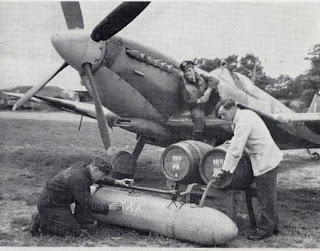In the lighter moments of World War II, the Spitfire was used in an unorthodox role: bringing beer kegs to the men in Normandy .
During the war, the Heneger and Constable brewery donated free beer to the troops. After D-Day, supplying the invasion troops in Normandy with vital supplies was already a challenge. Obviously, there was no room in the logistics chain for such luxuries as beer or other types of refreshments. Some men, often called "sourcers", were able to get wine or other niceties "from the land" or rather from the locals. RAF Spitfire pilots came up with an even better idea.
The Spitfire Mk IX was an evolved version of the Spitfire, with pylons under the wings for bombs or tanks. It was discovered that the bomb pylons could also be modified to carry beer kegs. According to pictures that can be found, various sizes of kegs were used. Whether the kegs could be jettisoned in case of emergency is unknown. If the Spitfire flew high enough, the cold air at altitude would even refresh the beer, making it ready for consumption upon arrival.
A variation of this was a long range fuel tank modified to carry beer instead of fuel.
The modification even received the official designation Mod. XXX. Propaganda services were quick to pick up on this, which probably explains the "official" designation.
Mod. XXX tank being filled.
As a result, Spitfires equipped with Mod XXX or keg-carrying pylons were often sent back to Great-Britain for "maintenance" or "liaison" duties. They would then return to Normandy with full beer kegs fitted under the wings.
Typically, the British Revenue of Ministry and Excise stepped in, notifying the brewery that they were in violation of the law by exporting beer without paying the relevant taxes. It seems that Mod. XXX was terminated then, but various squadrons found different ways to refurbish their stocks. Most often, this was done with the unofficial approval of higher echelons.
In his book "Dancing in the Skies", Tony Jonsson, the only Icelander pilot in the RAF, recalled beer runs while he was flying with 65 Squadron. Every week a pilot was sent back to the UK to fill some cleaned-up drop tanks with beer and return to the squadron. Jonsson hated the beer runs as every man on the squadron would be watching you upon arrival. Anyone who made a rough landing and dropped the tanks would be the most hated man on the squadron for an entire week.
The Spitfire had very little ground clearance with the larger beer kegs.
In his book "Typhoon Pilot", Desmond Scott also recalls Typhoon drop tanks filled with beer but regretted that it acquired a metallic taste.
Less imaginative techniques involved stashing bottles wherever space could be found on the aircraft, which included the ammunition boxes, luggage compartment or even in parts of the wing, with varying results. Champagne bottles in particular did not react well to the vibrations they were submitted to during such bootlegging trips.




No comments:
Post a Comment